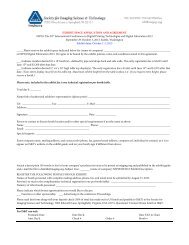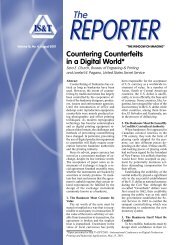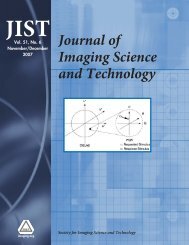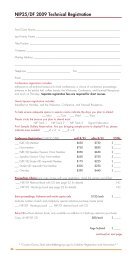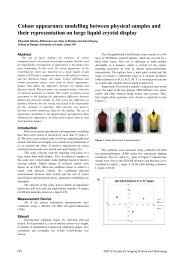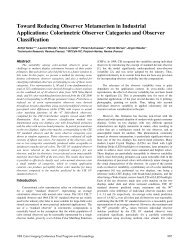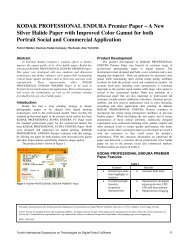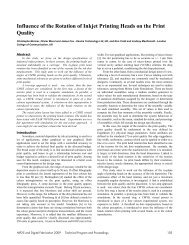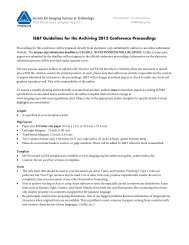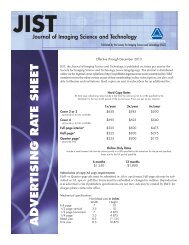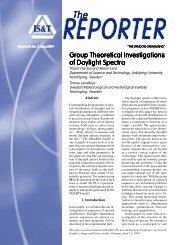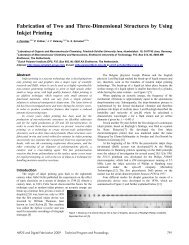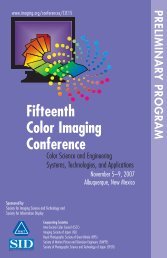JIST - Society for Imaging Science and Technology
JIST - Society for Imaging Science and Technology
JIST - Society for Imaging Science and Technology
You also want an ePaper? Increase the reach of your titles
YUMPU automatically turns print PDFs into web optimized ePapers that Google loves.
Lai et al.: Relationship between paper properties <strong>and</strong> fuser oil uptake in a high-speed digital xerographic printing fuser<br />
Relative Contact Area Between Paper <strong>and</strong> the Fuser Roll<br />
in the Nip<br />
Oil uptake is also examined with respect to the contact area<br />
between paper <strong>and</strong> oil within the fusing nip. This contact<br />
area is examined on the microscopic scale, where surfaces<br />
exhibit asperity peaks <strong>and</strong> valleys. As a result, when two<br />
surfaces touch, the real contact area is less than the nominal<br />
contact area. The relative contact area between paper <strong>and</strong> the<br />
fuser roll at the nip is modeled using theory from contact<br />
mechanics <strong>and</strong> in relation to the identified key nonsurface<br />
chemistry related properties (basis weight, caliper, stiffness,<br />
<strong>and</strong> rms roughness). The transfer of oil from the fuser roll to<br />
paper is then examined as a function of this relative contact<br />
area at the nip.<br />
Greenwood <strong>and</strong> Williamson developed a theory <strong>for</strong> the<br />
elastic contact of rough surfaces that takes into account surface<br />
topography <strong>and</strong> elastic de<strong>for</strong>mation based on Hertz<br />
theory. 12 The model assumed that contact occurs at the asperity<br />
peaks of the surface, <strong>and</strong> that the total contact area is<br />
the sum of the contacting areas of the peaks. According to<br />
Greenwood <strong>and</strong> Williamson, 12 <strong>for</strong> a negative exponentially<br />
distributed rough surface, the relative contact area parameter,<br />
A re , is defined as<br />
A re =k E,<br />
P 2<br />
where is the root-mean-square (rms) roughness value, E<br />
is a complex modulus defined in Eq. (3), <strong>and</strong> k is the rms<br />
value of the peak curvature <strong>and</strong> is defined in Eq. (4), 12<br />
1 1−<br />
E = paper <br />
+<br />
E paper<br />
2<br />
1− 2 roll <br />
. 3<br />
E roll<br />
A re is a dimensionless parameter describing the relative<br />
contact area between two rough surfaces or the ratio of real<br />
contact area to nominal contact area. This parameter describes<br />
the contact area between surfaces as a function of<br />
surface texture <strong>and</strong> compressibility of the substrate. The surface<br />
texture parameter was also defined as a dimensionless<br />
parameter, R f =k, by Yan <strong>and</strong> Aspler 13 ; <strong>and</strong> k are obtained<br />
from surface profile measurement data using Eq. (4),<br />
where z i−1 , z i , <strong>and</strong> z i+1 are three consecutive height measurements;<br />
h is the horizontal step interval between the height<br />
measurements; <strong>and</strong> N A is the total number of peaks measured.<br />
The rms roughness <strong>and</strong> k values <strong>for</strong> the test paper set<br />
are shown in Table III, <strong>and</strong> these values are in agreement<br />
4<br />
Table III. rms roughness <strong>and</strong> curvature parameter k values <strong>for</strong> all paper samples.<br />
Paper<br />
Sample<br />
No.<br />
rms<br />
Roughness<br />
µm<br />
St<strong>and</strong>ard<br />
Deviation<br />
<strong>for</strong> rms Roughness<br />
with those published by Yan <strong>and</strong> Aspler. 13 As expected, rms<br />
roughness values <strong>for</strong> uncoated papers are greater than those<br />
of coated papers. Curvature parameters appear to be greater<br />
<strong>for</strong> uncoated papers than <strong>for</strong> coated papers.<br />
Based on the work by Greenwood <strong>and</strong> Williamson 12 as<br />
well as Yan <strong>and</strong> Aspler, 13 a contact area index (CI) is developed<br />
to describe the degree of contact between the paper<br />
<strong>and</strong> the fuser roll at the nip [Eq. (5)]. This index represents<br />
the relative contact area as a function of rms roughness ,<br />
asperity peak curvature k, <strong>and</strong> complex modulus E. E<br />
combines the modulus of paper <strong>and</strong> that of the fuser roll. In<br />
this study, the fuser roll was silicon rubber <strong>and</strong> <strong>for</strong> Eq. (3),<br />
E roll =2 MPa, <strong>and</strong> Poisson’s ratio, roll =0.5, at 175°C were<br />
used 7 as estimated values <strong>for</strong> the fuser roll at fusing temperature.<br />
These values remained constant throughout the study.<br />
E paper was calculated using the bending stiffness of paper S<br />
<strong>and</strong> Eq. (6). 14 Changes in Poisson’s ratio among the paper<br />
samples were assumed to be negligible, <strong>and</strong> a constant Poisson’s<br />
ratio of paper =0.4 was used. 15 Pressure P within the<br />
fusing nip was estimated as a function of caliper (C), where<br />
P=C <strong>and</strong> is a constant, which depends on the spring<br />
constant of the nip,<br />
CI =<br />
A re<br />
= 1 C<br />
k E ,<br />
E paper = 12S<br />
C 3 .<br />
Average k<br />
1/µm<br />
St<strong>and</strong>ard<br />
Deviation<br />
<strong>for</strong> k<br />
Uncoated papers 1 5.83 0.38 1.35 0.05<br />
4 3.24 0.11 0.74 0.04<br />
5 4.84 0.17 1.21 0.03<br />
7 4.10 0.38 1.02 0.14<br />
8 4.73 0.05 1.16 0.12<br />
Coated papers 2 1.25 0.01 0.17 0.02<br />
3 1.20 0.11 0.20 0.02<br />
6 1.40 0.04 0.20 0.01<br />
9 1.61 0.11 0.30 0.04<br />
10 1.44 0.03 0.24 0.01<br />
11 1.61 0.06 0.25 0.01<br />
12 1.81 0.13 0.29 0.02<br />
13 1.80 0.16 0.26 0.01<br />
14 1.58 0.09 0.24 0.01<br />
15 1.50 0.02 0.28 0.004<br />
16 1.26 0.05 0.17 0.01<br />
Although CI is not a measurement <strong>for</strong> the actual contact<br />
area between paper <strong>and</strong> the fuser roll at the nip, it is an<br />
5<br />
6<br />
428 J. <strong>Imaging</strong> Sci. Technol. 515/Sep.-Oct. 2007



